1994 PONTIAC GRAND-AM wheel
[x] Cancel search: wheelPage 167 of 274
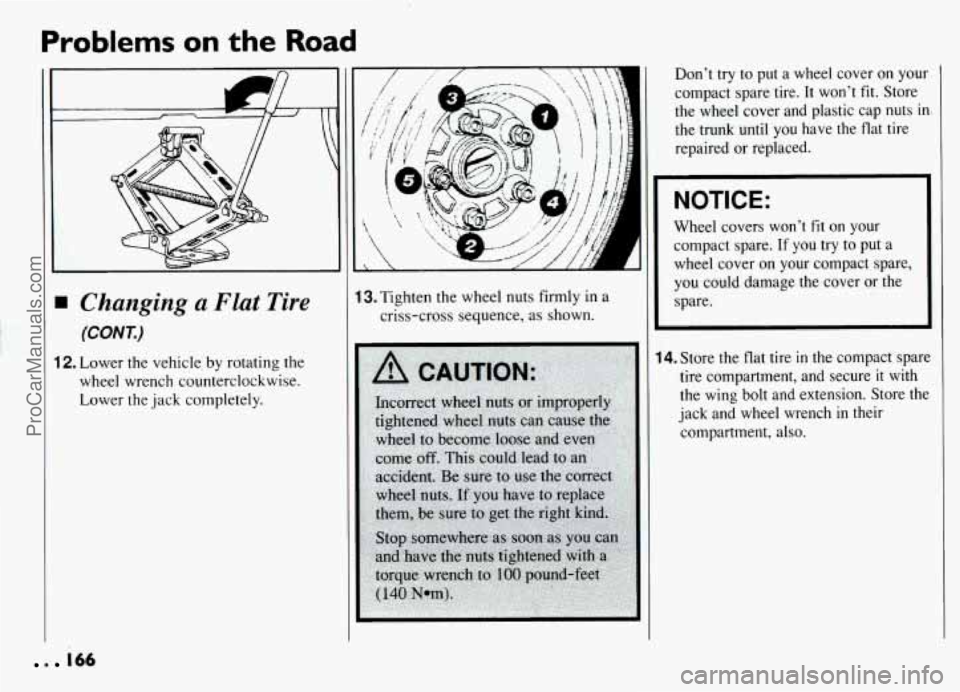
Problems on the Road
II
Changing a Flat Tire
(CONT.)
12. Lower the vehicle by rotating the
wheel wrench counterclockwise.
Lower the jack completely.
A
13. Tighten the wheel nuts firmly in a
criss-cross sequence, as shown.
Don’t try to put a wheel cover on your
compact spare tire. It won’t
fit. Store
the wheel cover and plastic cap nuts
int
the trunk until you have the flat tire
repaired or replaced.
NOTICE:
Wheel covers won’t fit on your
compact spare.
If you try to put a
wheel cover on your compact spare,
you could damage the cover or the
spare.
14. Store the flat tire in the compact spare
tire compartment, and secure
it with
the wing bolt and extension. Store the
jack and wheel wrench
in their
compartment, also.
. 166
ProCarManuals.com
Page 168 of 274
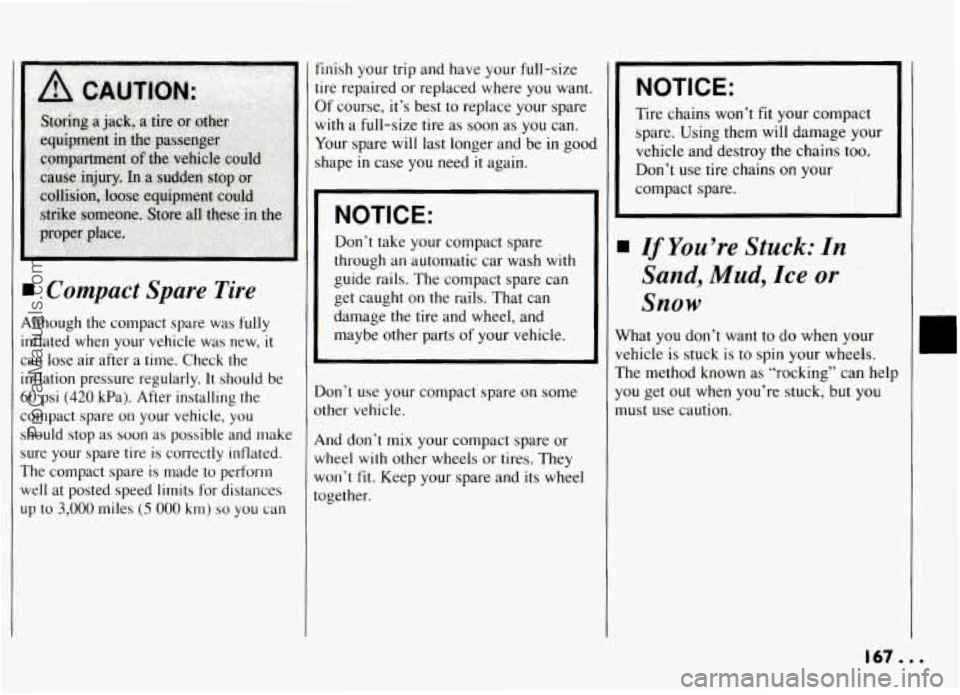
P
t
I
A
ir:
in
Ci
SL
W
I Compact Spare Tire
hhough the compact spare was fully
lflated when your vehicle was new, it
in lose air after a time. Check the
iflation pressure regularly. It should be
3 psi (420 kPa). After installing the
Impact spare on your vehicle, you lould stop as soon as possible and make
ire your spare tire is correctly inflated.
he compact spare is made to perform
ell at posted speed limits for distances
J to 3,000 miles (5 000 km) so you can
finish your trip and have your full-size
tire repaired or replaced where you want.
Of course, it’s best to replace your spare
with a full-size tire as soon as you can.
Your spare will last longer and be
in good
shape
in case you need it again.
NOTICE:
Don’t take your compact spare
through an automatic car wash
with
guide rails. The compact spare can
get caught on the rails. That can
damage the tire and wheel, and
maybe other parts of your vehicle.
Don’t use your compact spare on some
other vehicle.
And don’t mix your compact spare or
wheel
with other wheels or tires. They
won’t fit. Keep your spare and its wheel
:ogether.
NOTICE:
Tire chains won’t fit your compact
spare. Using them will damage your
vehicle and destroy the chains too.
Don’t use tire chains on your
compact spare.
If You’re Stuck: In
Sand, Mud, Ice or
Snow
Jhat you don’t want to do when your
zhicle is stuck is to spin your wheels.
The method known as “rocking” can help
you get out when you’re stuck, but you
must use caution.
167 ...
ProCarManuals.com
Page 169 of 274
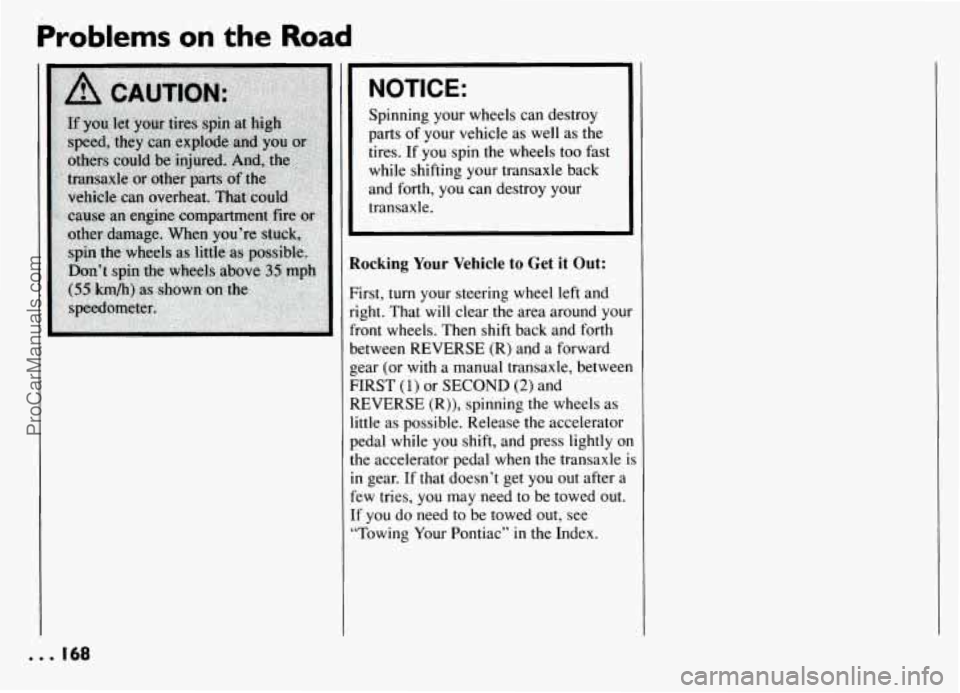
Problems on the Road
NOTICE:
Spinning your wheels can destroy
parts of your vehicle
as well as the
tires. If you spin the wheels too fast
while shifting your transaxle back
and forth, you can destroy your
transaxle.
..
locking Your Vehicle to Get it Out:
‘irst, turn your steering wheel left and
ight. That will clear the area around your
ront wheels. Then shift back and forth
letween REVERSE (R) and a forward
ear (or with a manual transaxle, between
IRST
(1) or SECOND (2) and
.EVERSE
(R)), spinning the wheels as
ttle as possible. Release
the accelerator
edal while you shift, and press lightly
on
le accelerator pedal when the transaxle is
1 gear. If that doesn’t get you out after a
:w tries, you may need to be towed out.
F you do need to be towed out, see
Towing Your Pontiac”
in the Index.
ProCarManuals.com
Page 201 of 274
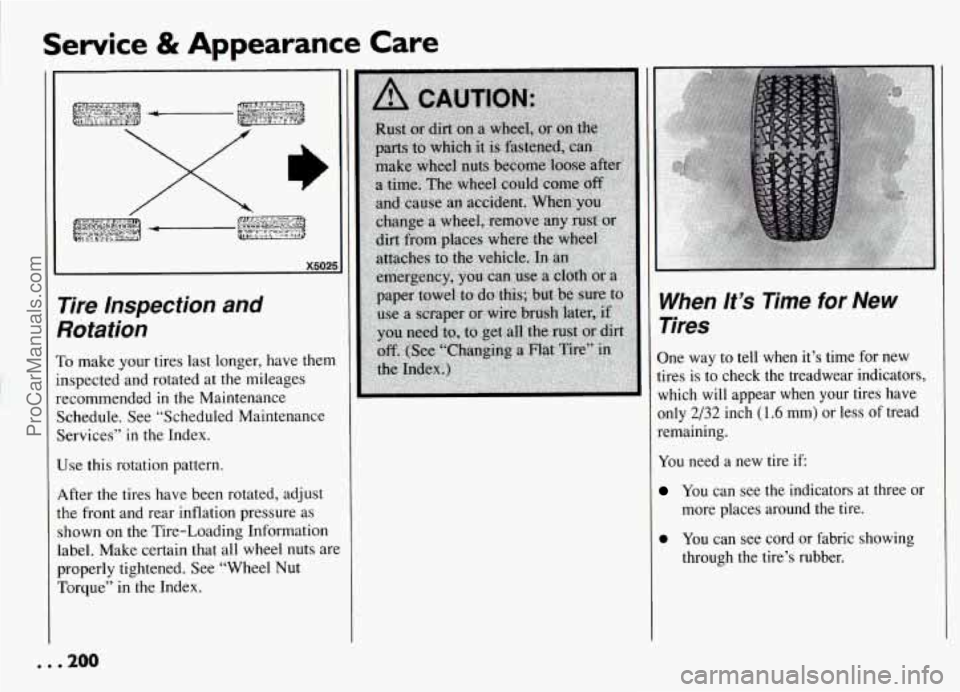
Service & Appearance Care
Tire Inspection and qotation
i’o make ,your tires last longer, have them
nspected and rotated at the mileages
ecommended
in the Maintenance
ichedule. See “Scheduled Maintenance
jervices”
in the Index.
Jse this rotation pattern.
4fter the tires have been rotated, adjust
he front and rear inflation pressure as
;hown on the Tire-Loading Information
abel. Make certain that all wheel nuts arc
xoperly tightened. See “Wheel Nut
rorque” in the Index.
When It’s Time for New
Tires
One way to tell when it’s time for new
tires is to check the treadwear indicators,
which
will appear when your tires have
only
2/32 inch (1.6 mm) or less of tread
remaining.
You need a new tire if
You can see the indicators at three or
more places around the tire.
0 You can see cord or fabric showing
through the tire’s rubber.
ProCarManuals.com
Page 203 of 274
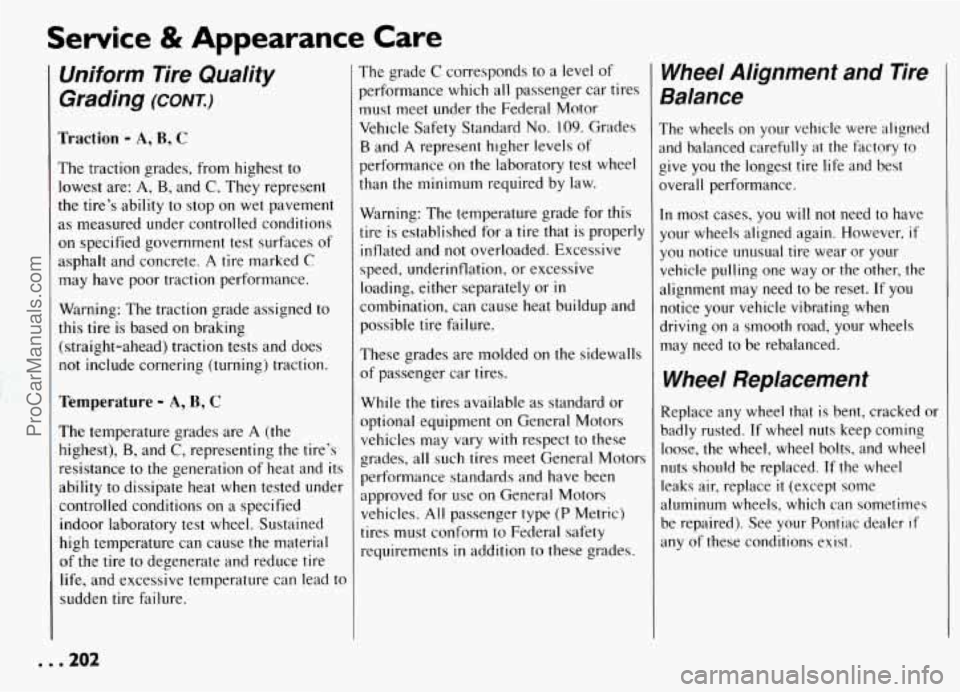
Service & Appearance Care
Uniform Tire Quality
Grading
(CONT.)
Traction - A, B, C
The traction grades, from highest to
lowest are: A,
B, and C. They represent
the tire’s ability to stop on wet pavement
as measured under controlled conditions
on specified government test surfaces of
asphalt and concrete.
A tire marked C
may have poor traction performance.
Warning: The traction grade assigned to
this tire is based on braking
(straight-ahead) traction tests and does
not include cornering (turning) traction.
Temperature - A, B, C
The temperature grades are A (the
highest),
B, and C, representing the tire’s
resistance to the generation
of heat and its
ability to dissipate heat when tested under
controlled conditions on a specified
indoor laboratory test wheel. Sustained
high temperature can cause the material
of the tire to degenerate and reduce tire
life, and excessive temperature can lead to
sudden tire failure.
The grade C corresponds to a level of
performance which all passenger car tires
must meet under the Federal Motor
Vehicle Safety Standard
No. 109. Grades
B and A represent higher levels of
performance on the laboratory test wheel
than the minimum required by law.
Warning: The temperature grade for this
tire is established for a tire that is properly
inflated and not overloaded. Excessive
speed, underinflation, or excessive
loading, either separately or
in
combination, can cause heat buildup and
possible tire failure.
These grades are molded on the sidewalls
of passenger car tires.
While the tires available as standard or
optional equipment on General Motors
vehicles may vary with respect to these
grades, all such tires meet General Motors
performance standards and have been
approved for use on General Motors
vehicles. All passenger type
(P Metric)
tires must conform to Federal safety
requirements
in addition to these grades.
Wheel Alignment and Tire
Balance
The wheels on your vehicle were aligned
and balanced carefully
at the factory to
give you the longest tire life and best
werall performance.
[n most cases, you will not need to have
your wheels aligned again. However,
if
you notice unusual tire wear or your
vehicle pulling one way or the other, the
alignment may need to be reset. If you
notice your vehicle vibrating when
driving on a smooth road, your wheels
may need to be rebalanced.
Wheel Replacement
Replace any wheel that is bent, cracked or
badly rusted. If wheel nuts keep coming
loose, the wheel, wheel bolts, and wheel
nuts should be replaced. If the wheel
leaks air, replace
it (except some
aluminum wheels, which can sometimes
be repaired). See your Pontiac dealer
if
any of these conditions exist.
. . .202
ProCarManuals.com
Page 204 of 274

Your dealer will know the kind of wheel
you need.
Each new wheel should have the same
load carrying capacity, diameter, width,
offset, and be mounted the same way as
the one
it replaces.
If you need to replace any of your wheels,
wheel bolts, or wheel nuts, replace them
only
with new GM original equipment
parts. This way, you
will be sure to have
the right wheel, wheel bolts, and wheel
nuts for your Pontiac model.
NOTICE:
The wrong wheel can also cause
problems
with bearing life, brake
cooling, speedometer/odometer
calibration, headlight aim, bumper
height, vehicle ground clearance,
and tire or tire chain clearance to the
body and chassis.
Used Replacement Wheels
‘ire Chains
NOTICE:
If your Pontiac has P195/70R14,
P2 15/60VR 14, P195/65R 15 or
P205/55R16 size tires, don’t use tire
chains; they can damage your
vehicle.
If you have other tires, use tire
chains only where legal and on
when you must. Use only
SAE
Class “S” type chains that are the
proper size for your tires. Install
them on the front tires and tighten
them as tightly
as possible with the
ends securely fastened. Drive slowly and follow the chain
manufacturer’s instructions. If you
can hear the chains contacting your
vehicle, stop and retighten them. If
the contact continues, slow down
until- it stops. Driving too fast with
chains on will damage your vehicle.
lr
ProCarManuals.com
Page 209 of 274
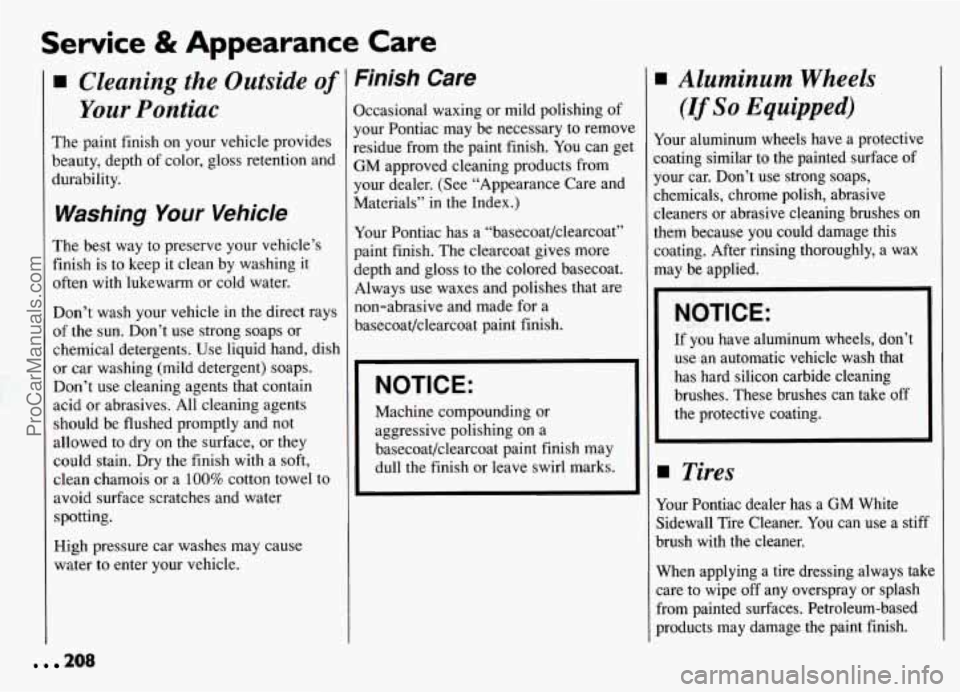
Service & Appearance Care
Cleaning the Outside of
Your Pontiac
The paint finish on your vehicle provides
beauty, depth of color, gloss retention and
durability.
Washing Your Vehicle
The best way to preserve your vehicle’s
finish is to keep it clean by washing it
often with ‘lukewarm or cold water.
Don’t wash your vehicle in the direct rays
of the sun. Don’t use strong soaps or
chemical detergents. Use liquid hand, dish
or car washing (mild detergent) soaps.
Don’t use cleaning agents that contain
acid or abrasives. All cleaning agents
should be flushed promptly and not
allowed to dry on the surface, or they
could stain. Dry the finish with a soft,
clean chamois or a 100% cotton towel to
avoid surface scratches and water
spotting.
High pressure car washes may cause
water to enter your vehicle.
Finish Care
Occasional waxing or mild polishing of
your Pontiac may be necessary to remove
residue from the paint finish. You can get
GM approved cleaning products from
your dealer. (See “Appearance Care and
Materials” in the Index.)
Your Pontiac has a “basecoat/clearcoat”
paint finish. The clearcoat gives more
depth and gloss to the colored basecoat.
Always use waxes and polishes that are
non-abrasive and made for a
basecoat/clearcoat paint finish.
NOTICE:
Machine compounding or
aggressive polishing on a
basecoat/clearcoat paint finish may
dull the finish or leave swirl marks.
I
’I
1
1
Aluminum Wheels
(If So Equipped)
Your aluminum wheels have a protective
:eating similar to the painted surface of
your car. Don’t use strong soaps,
zhernicals, chrome polish, abrasive
:leaners
or abrasive cleaning brushes on
them because you could damage this
coating. After rinsing thoroughly, a wax
may be applied.
NOTICE:
If you have aluminum wheels, don’t
use an automatic vehicle wash that
has hard silicon carbide cleaning brushes. These brushes can take
off
the protective coating.
Tires
Your Pontiac dealer has a GM White
Sidewall Tire Cleaner. You can use a stiff
brush with the cleaner.
When applying a tire dressing always take
care to wipe
off any overspray or splash
from painted surfaces. Petroleum-based
products may damage the paint finish.
208
ProCarManuals.com
Page 217 of 274
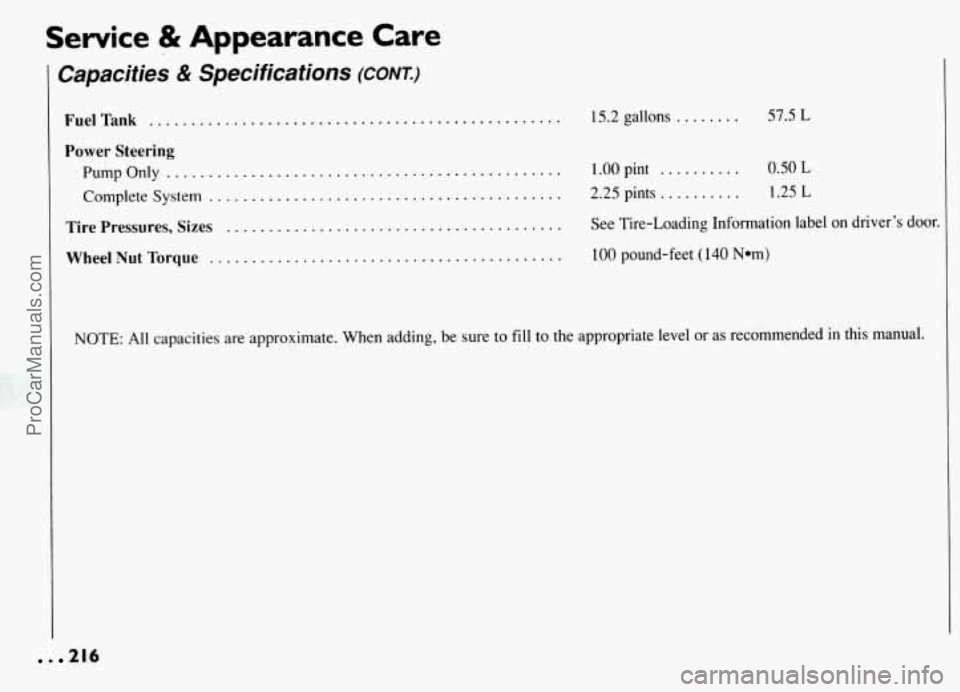
Service & Appearance Care
Capacities & Specifications (CONT.)
Complete System . .
Tire Pressures, Sizes
Wheel
Nut Torque . .
FuelTank .................................................
Power Steering
PumpOnly ...............................................
......................................
........................................
........................................
15.2 gallons ........ 57.5 L
1.00 pint .......... 0.50 L
2.25 pints .......... 1.25 L
See Tire-Loading Information label on driver’s door.
100 pound-feet ( 140 N*m)
NOTE: All capacities are approximate. When adding, be sure to fill to the appropriate level or as recommended in this manual.
. 216
ProCarManuals.com